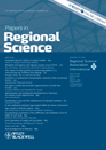 Authors: M. J. Herrerías, Vicente Orts and Emili Tortosa-Ausina
Authors: M. J. Herrerías, Vicente Orts and Emili Tortosa-AusinaTitle: Weighted convergence and regional clusters across China
Source: Papers in Regional Science
Abstract: We analyse per capita GDP convergence among 28 Chinese provinces between 1952 and 2005 using the distribution dynamics approach. Compared with previous studies, we provide a more complete view by including some additional information such as the asymptotic half-life of convergence, mobility indices and the continuous version of the ergodic distributions. In addition, we also extend the analysis to evaluate whether patterns could differ if weighted by either the population living in each province or their economic sizes, together with the existence and magnitude of spatial spillovers. The unweighted, unconditional analysis corroborates and supplements previous findings, especially those indicating that convergence patterns differ strongly under either pre- or post-reform trends. Both the weighted and space-conditioned analyses indicate that convergence could be much faster when these factors are introduced in the analysis. Implications are especially relevant when weighing by population, since results indicate that the number of people escaping from relative poverty would be much higher than the figure predicted by the unweighted analysis.
Recommended citation:
Herrerías, M.J., V. Orts and E. Tortosa, 2011. "Weighted convergence and regional clusters across China", Papers in Regional Science, 90(4), November, pp. 703-735.
Further articles






